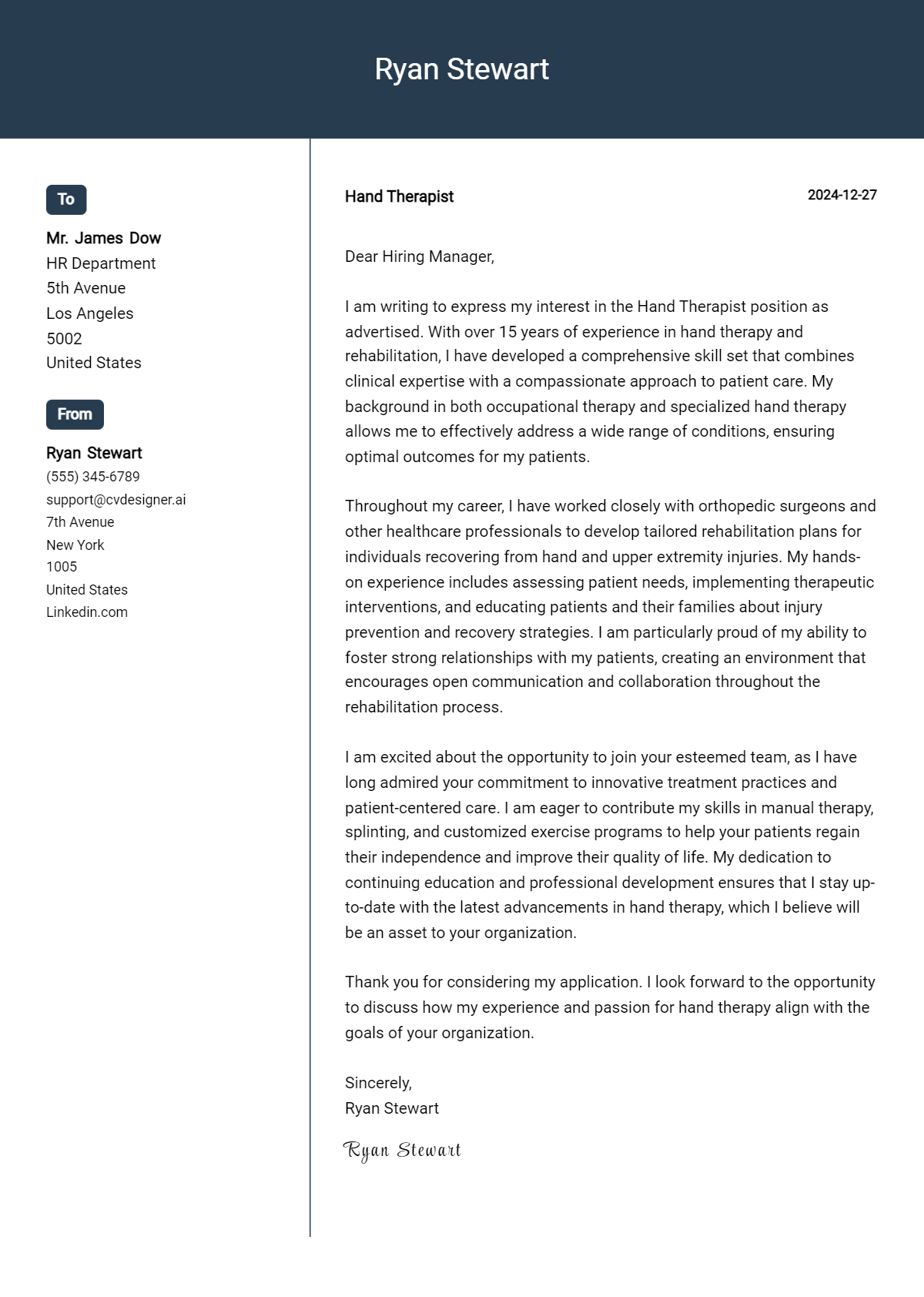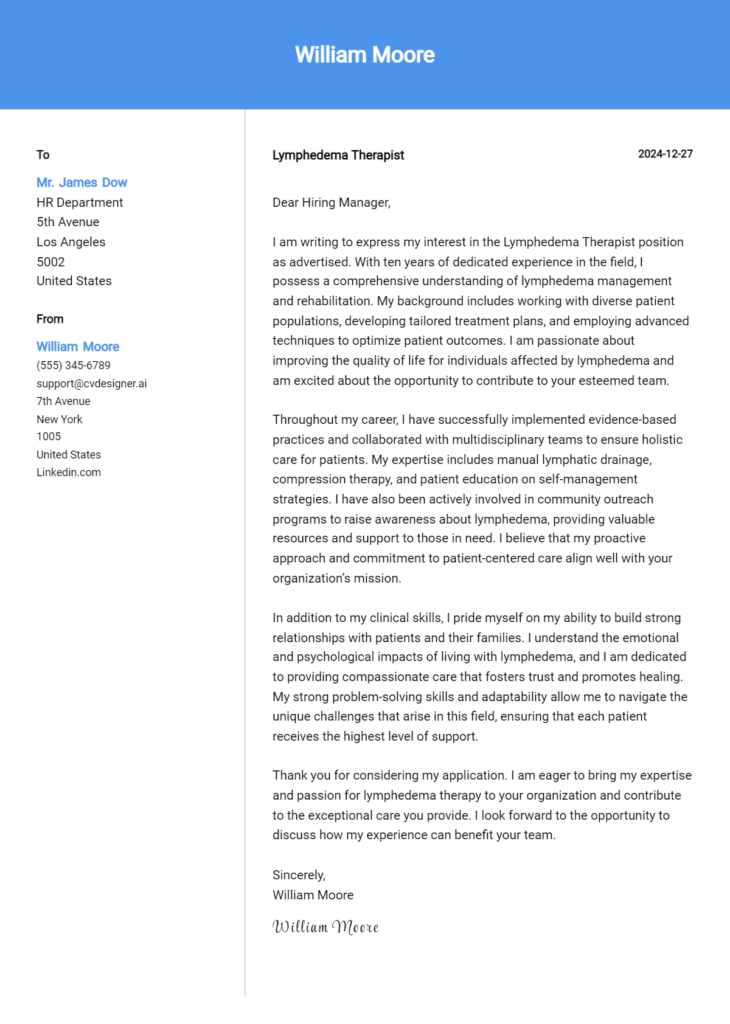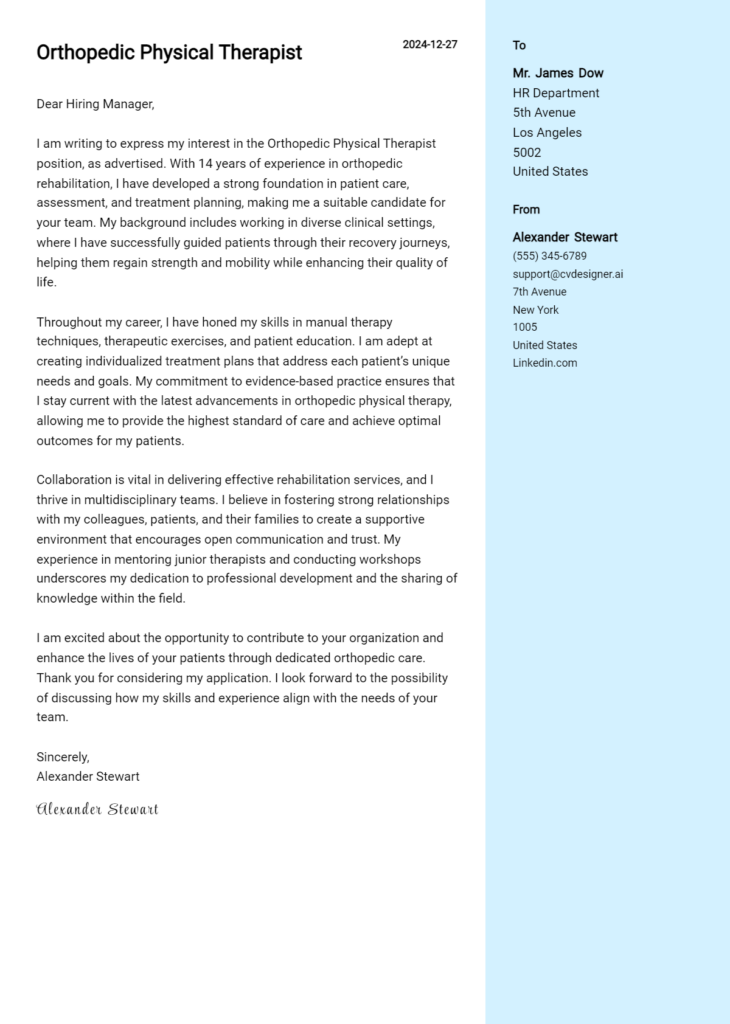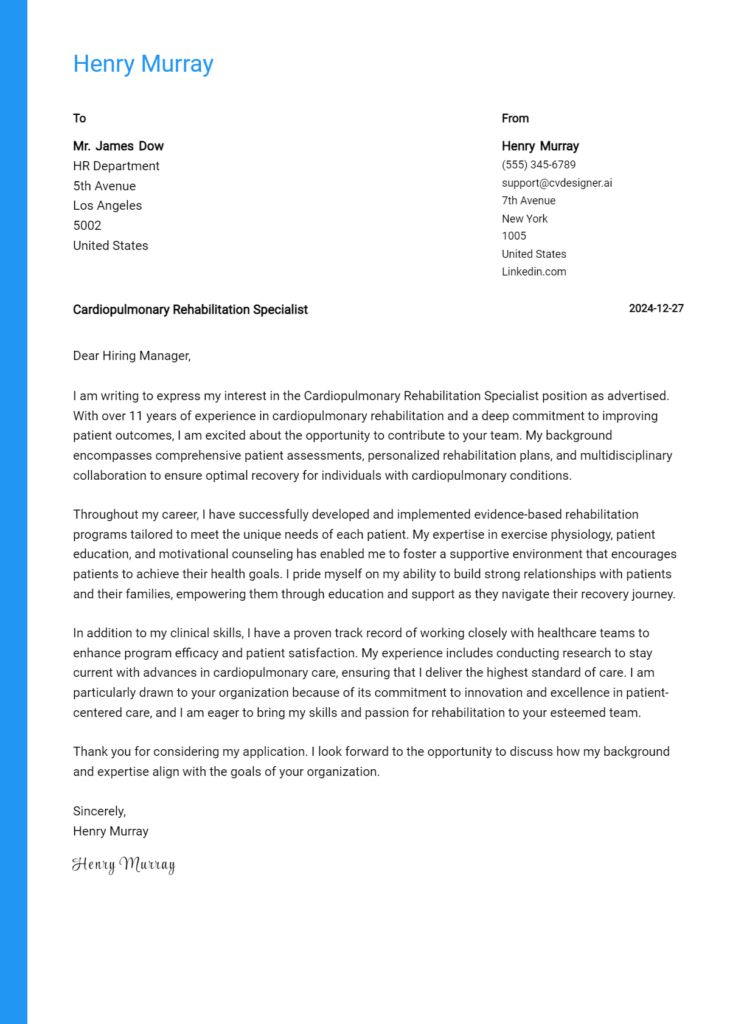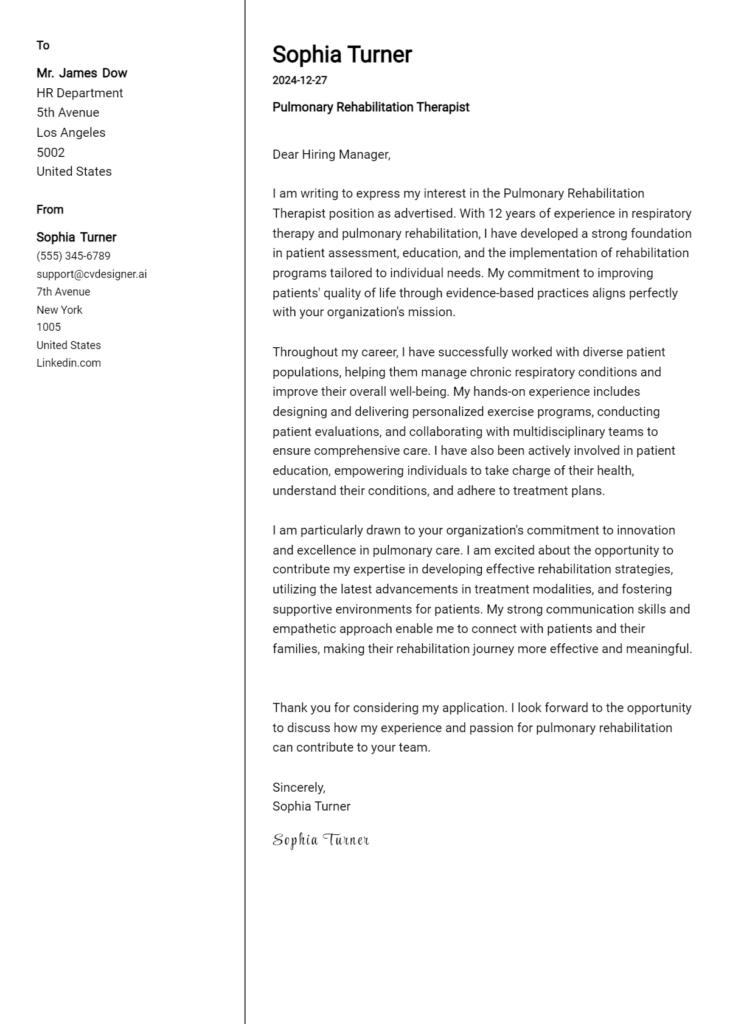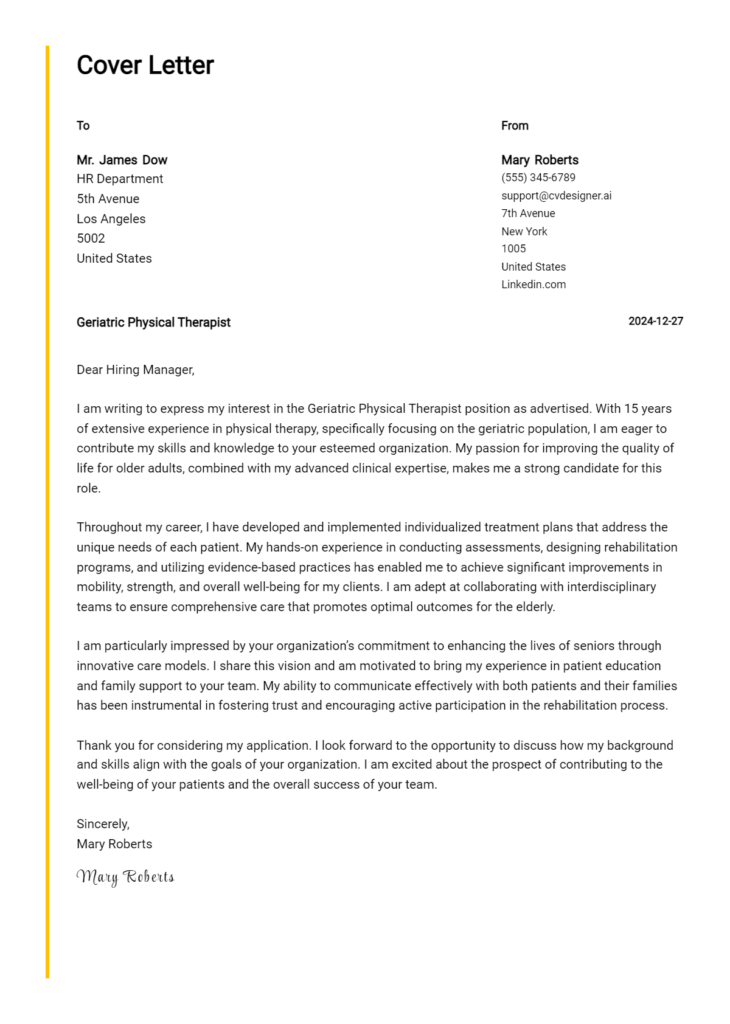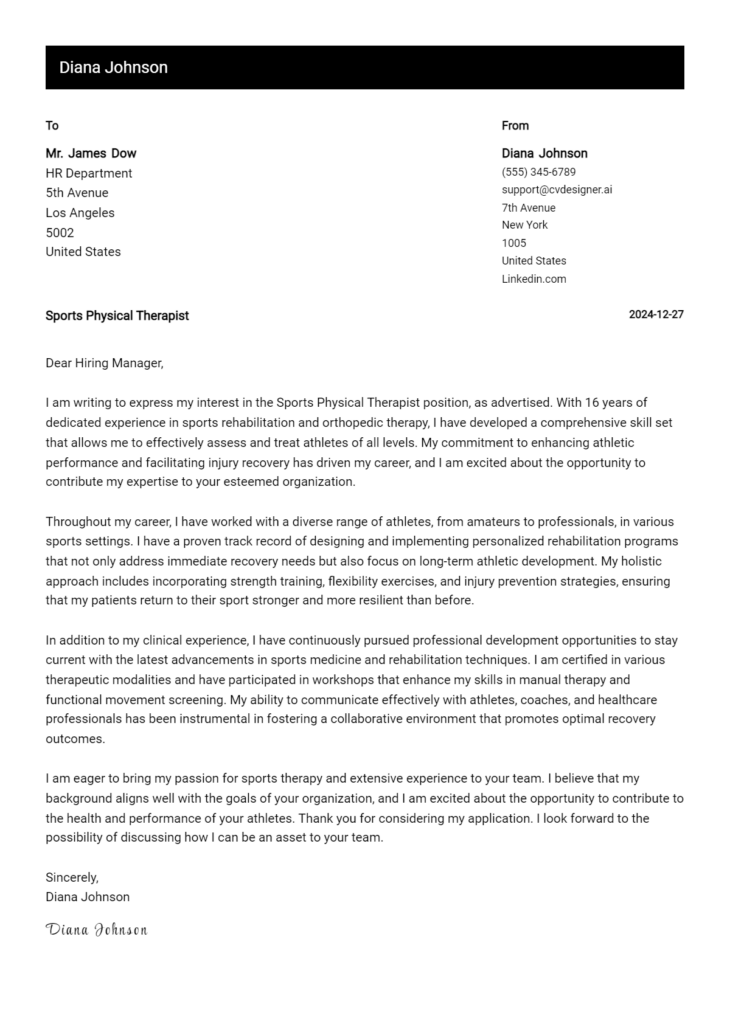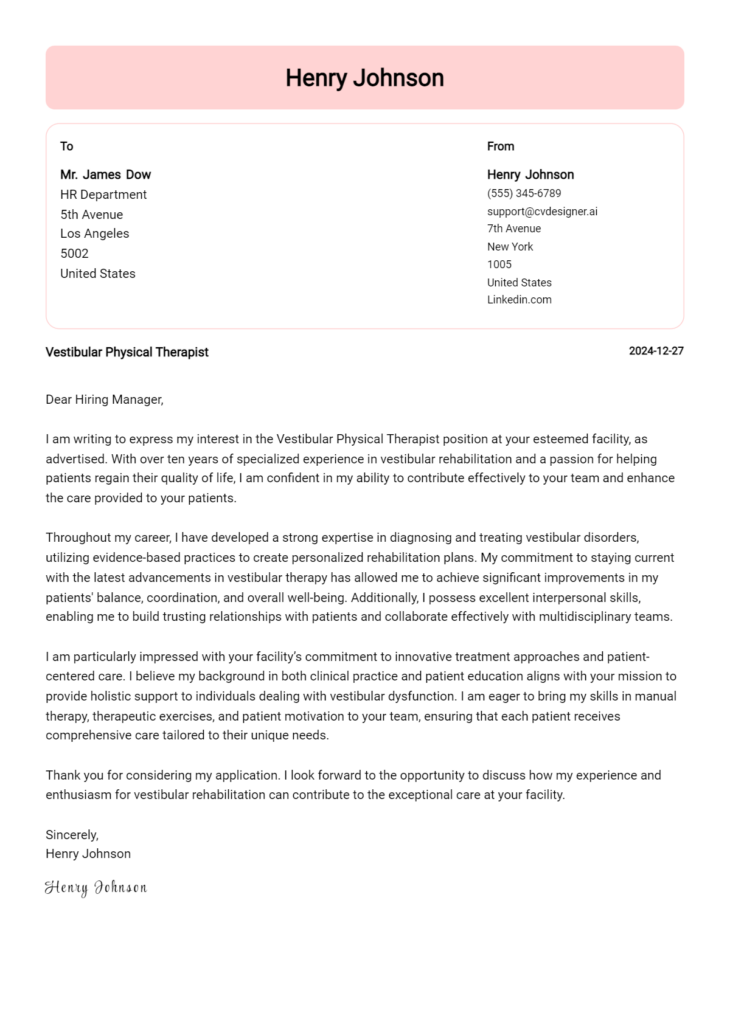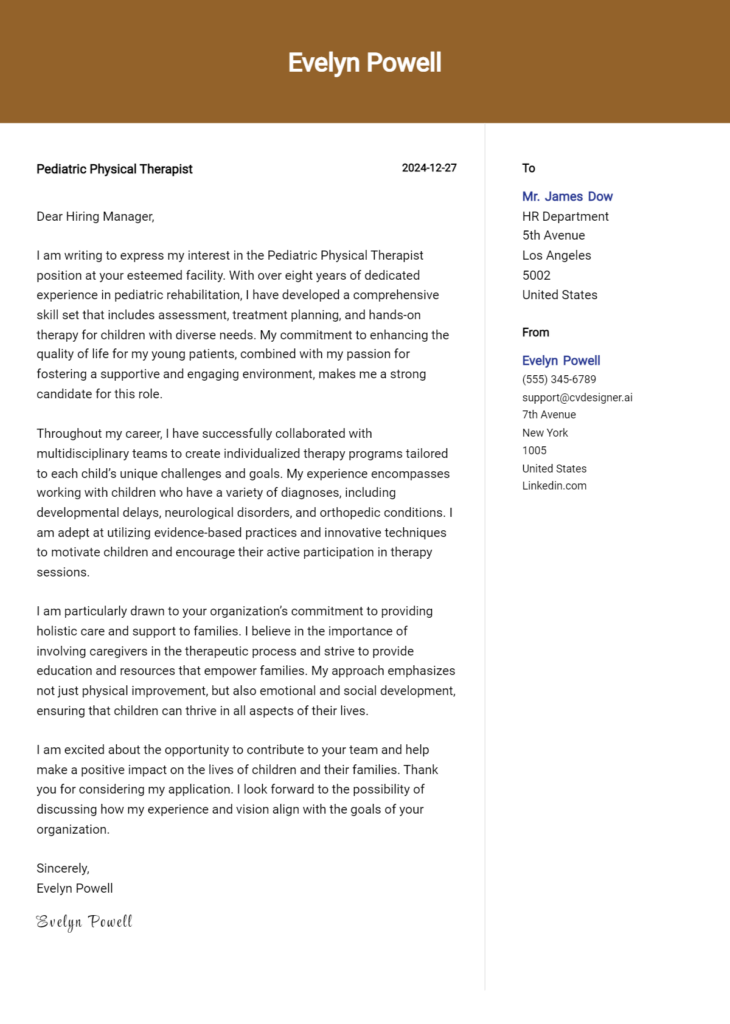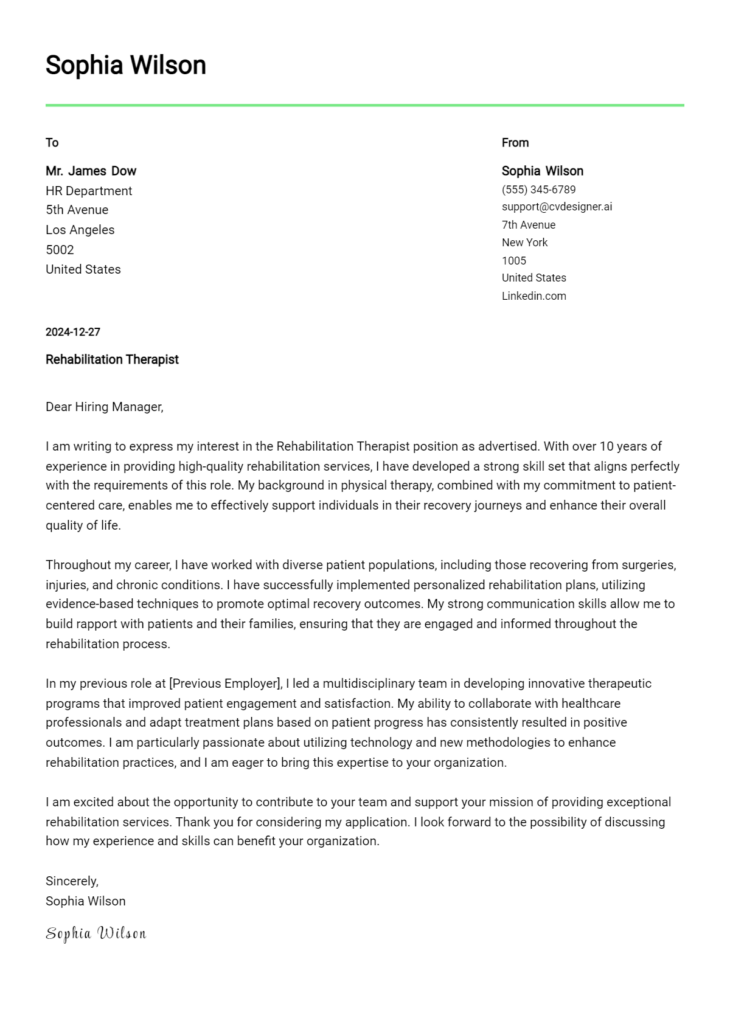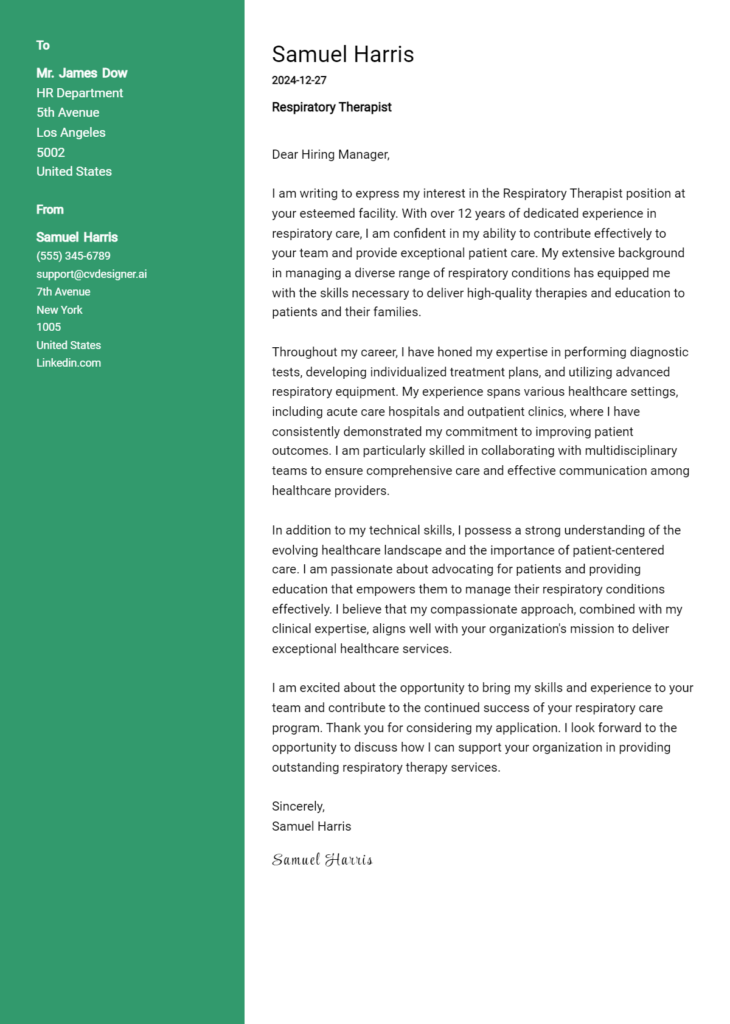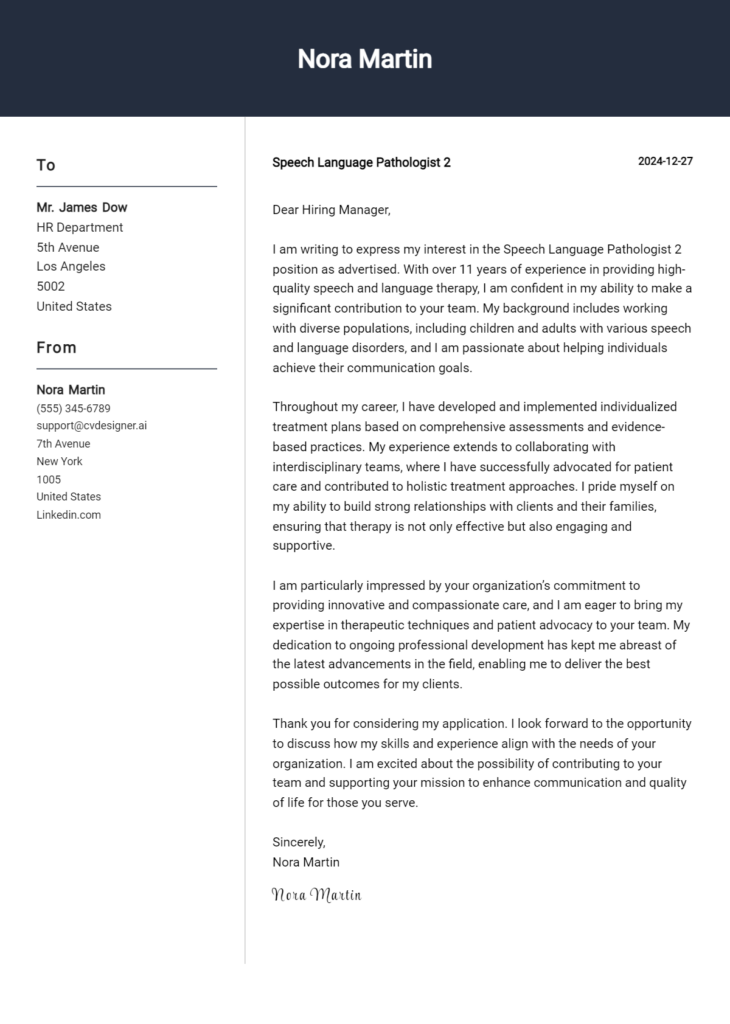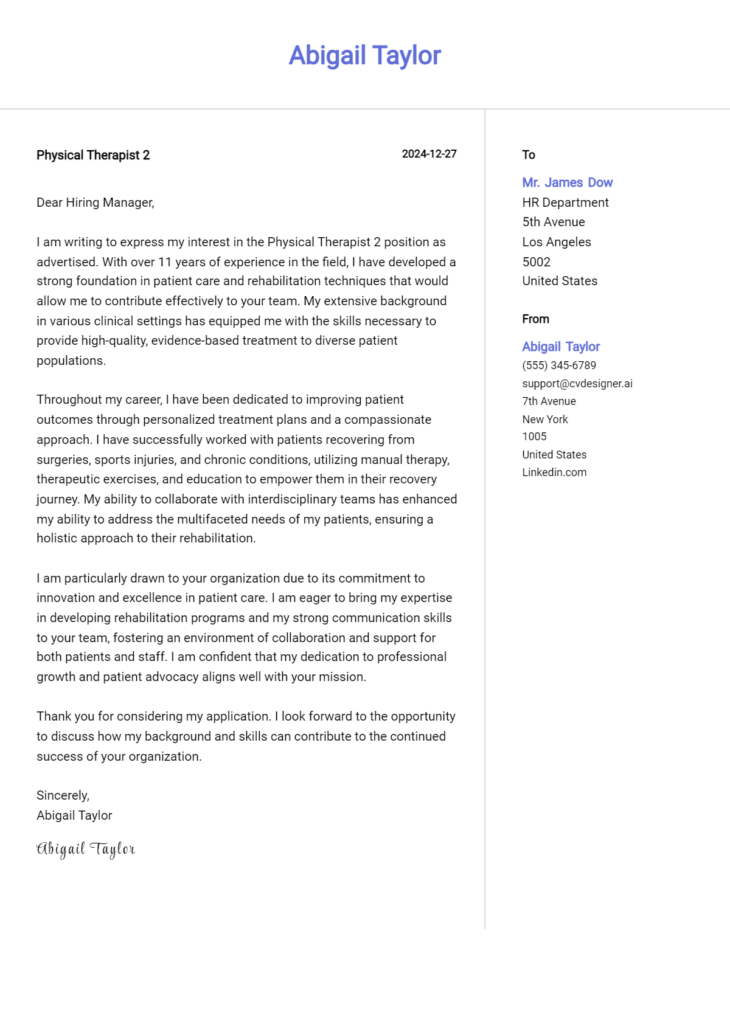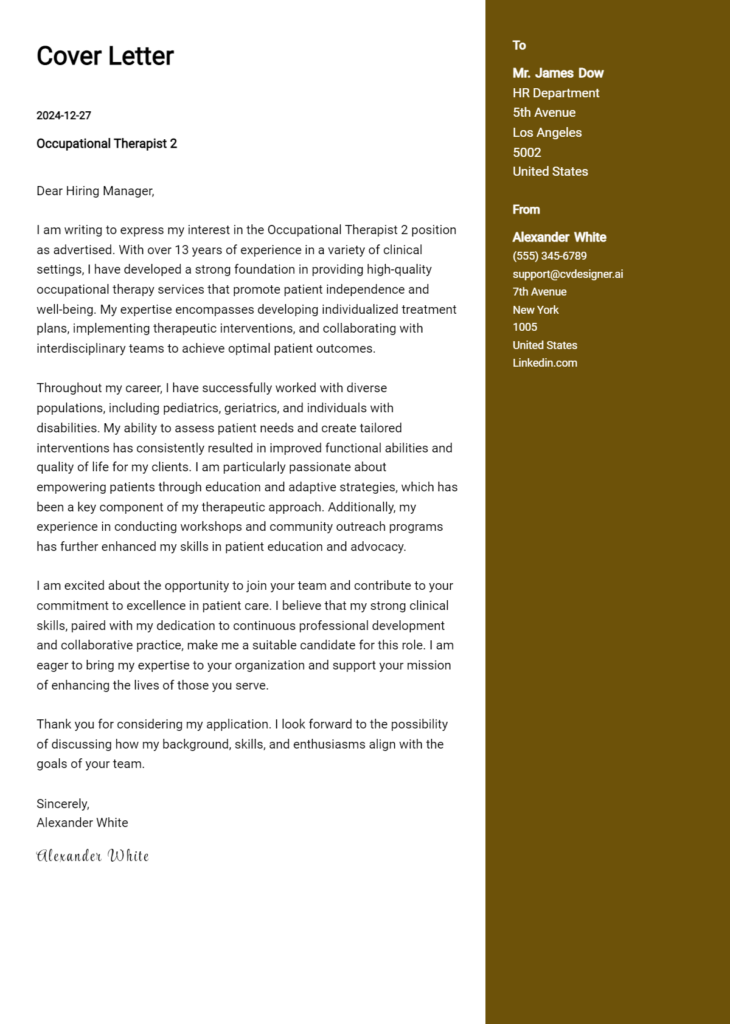Hand Therapist Cover Letter Examples
Explore additional Hand Therapist cover letter samples and guides and see what works for your level of experience or role.
How to Format a Hand Therapist Cover Letter?
Crafting an effective cover letter is essential for a Hand Therapist, as it serves as your first impression to potential employers. The way you present your qualifications and experience conveys not only your clinical skills but also your empathy, attention to detail, and commitment to patient care. A well-structured cover letter captures the hiring manager's interest while demonstrating your professionalism, which is crucial in the healthcare field.
In this guide, we will discuss how to format your cover letter to make it stand out. We’ll focus on the essential components, including:
- Cover Letter Header
- Cover Letter Greeting
- Cover Letter Introduction
- Cover Letter Body
- Cover Letter Closing
Each section plays a vital role in highlighting your expertise and dedication to hand therapy. Let’s break down each part and explore how to create a compelling cover letter that showcases your qualifications effectively.
Importance of the Cover Letter Header for a Hand Therapist
The cover letter header is a crucial component of your application as a Hand Therapist. It serves as the first impression and sets the tone for the rest of your letter. A well-organized header not only reflects your professionalism but also ensures that your contact information is easily accessible to the recipient. A clear header should include your name, address, phone number, and email, followed by the date and the recipient’s name and address. This organization contributes to clarity, making it easier for hiring managers to reach out to you.
Strong Example
Jane Doe, OTR/L 123 Therapy Lane Wellness City, ST 12345 (123) 456-7890 jane.doe@email.com October 15, 2023 Mr. John Smith Hiring Manager HealthCare Solutions 456 Care Street Health Town, ST 67890
Weak Example
Jane Doe 123 Therapy Lane Wellness City October 15, 2023 To Whom It May Concern,
The Importance of a Cover Letter Greeting for a Hand Therapist
The greeting of a cover letter is crucial as it sets the tone for the rest of the document, establishing a connection with the hiring manager from the very beginning. A well-crafted greeting not only demonstrates professionalism but also shows that you have taken the time to personalize your application. Addressing the hiring manager directly can create a sense of rapport, making your cover letter more engaging. To avoid generic greetings that can make your letter blend into the pile, it's essential to research and find the recipient's name if possible. This small effort can significantly elevate your application and enhance your chances of standing out.
Strong Example
Dear Ms. Johnson,
Weak Example
To Whom It May Concern,
The Importance of a Captivating Cover Letter Introduction for a Hand Therapist
As a Hand Therapist, your cover letter serves as a vital first impression, and the introduction is its heartbeat. A well-crafted introduction not only captures the hiring manager's attention but also expresses your genuine interest in the role while briefly showcasing your most relevant skills and achievements. This initial paragraph sets the tone for the rest of your application and can significantly impact whether your resume gets a closer look. Below, we present both strong and weak examples of cover letter introductions for a Hand Therapist role to illustrate the difference.
Strong Example
Dear [Hiring Manager's Name], I am excited to apply for the Hand Therapist position at [Company Name], where I can leverage my extensive experience in rehabilitating patients with upper extremity injuries. With over five years of specialized practice in hand therapy, I have successfully developed individualized treatment plans that have resulted in a 90% patient satisfaction rate. I am passionate about empowering individuals to regain their functionality and independence, and I believe my skills align perfectly with the mission of your team.
Weak Example
To Whom It May Concern, I am writing to apply for the Hand Therapist position at your company. I have some experience in therapy, and I think I could do a decent job. I hope you will consider my application.
Purpose of the Cover Letter Body for a Hand Therapist
The cover letter body for a Hand Therapist serves as a crucial platform for the candidate to demonstrate their specialized skills, relevant experiences, and the unique value they bring to the prospective employer. It is an opportunity to highlight specific projects or accomplishments that showcase their proficiency in hand therapy, such as successful rehabilitation programs or innovative treatment methods that have led to improved patient outcomes. By providing concrete examples of their achievements and how they align with the organization's goals, candidates can effectively communicate their potential contributions to the team.
Strong Example
I am excited to apply for the Hand Therapist position at [Company Name], as I believe my extensive experience in post-operative rehabilitation and my passion for patient-centered care make me an excellent fit. During my previous role at [Previous Company], I led a collaborative initiative to redesign our hand therapy protocols, resulting in a 25% increase in patient satisfaction scores over six months. Additionally, I developed a specialized program for patients recovering from tendon repairs, which decreased recovery time by an average of two weeks. I am eager to bring this proactive approach and my commitment to excellence in patient care to your esteemed team.
Weak Example
I am applying for the Hand Therapist job at [Company Name]. I have worked in hand therapy for a while and have helped many patients. I think I would be a good addition to your team. In my last job, I did some projects related to hand therapy, but I can't remember the details. I am looking forward to the opportunity to work with you.
Importance of the Cover Letter Closing for a Hand Therapist
The closing paragraph of a cover letter is crucial for leaving a lasting impression on potential employers. It serves to summarize your qualifications, reiterate your enthusiasm for the role, and encourage the hiring manager to take the next steps, such as reviewing your resume or scheduling an interview. A strong closing can effectively reinforce your fit for the position and express your eagerness to contribute to their team, while a weak closing may leave your application feeling incomplete or uninspired.
Strong Example
Thank you for considering my application for the Hand Therapist position at [Company Name]. With my extensive experience in rehabilitation and a passion for helping patients regain their mobility, I am excited about the opportunity to contribute to your team. I am looking forward to the possibility of discussing how my skills and experiences align with the needs of your clinic. Please feel free to review my attached resume, and I hope to hear from you soon to schedule an interview.
Weak Example
I hope you think about my application. I have some relevant experience and would like to work for your company. Please look at my resume. Thank you.
These tips will guide candidates in crafting an effective cover letter for a Hand Therapist position. A well-written cover letter is crucial for showcasing not only your technical skills and problem-solving abilities but also your knowledge of the software development life cycle (SDLC), your capacity for teamwork, and your passion for continuous learning. By emphasizing these elements, you can demonstrate your qualifications and commitment to the role, making you a standout candidate.
Tips for Writing a Cover Letter as a Hand Therapist
Highlight Your Technical Skills: Begin by detailing your specific hand therapy techniques and methods. Mention any specialized training or certifications you have, such as splinting, manual therapy, or rehabilitation technology. Using keywords relevant to the field can also help your application stand out.
Showcase Problem-Solving Abilities: Provide examples of how you have successfully addressed challenging cases in your previous roles. Discuss specific situations where your critical thinking and problem-solving skills led to improved patient outcomes. This demonstrates your ability to navigate complex scenarios effectively.
Demonstrate Knowledge of SDLC: If applicable, mention your understanding of the software development life cycle, especially if you have experience with therapy management software. Highlight how you’ve utilized such tools to enhance patient care or streamline processes, showcasing your ability to adapt to new technologies in your practice.
Emphasize Teamwork: In hand therapy, collaboration with other healthcare professionals is essential. Mention instances where you worked effectively as part of a multidisciplinary team. Highlight your communication skills and your ability to contribute positively to team dynamics, which is vital in achieving the best patient outcomes.
Express a Passion for Continuous Learning: The field of hand therapy is ever-evolving, so it’s important to convey your commitment to professional development. Discuss any recent courses, workshops, or conferences you’ve attended to advance your knowledge and skills. This not only reflects your dedication but also your eagerness to stay current with industry advancements.
For additional assistance in crafting your cover letter, consider utilizing cover letter templates or a cover letter builder that can help streamline the process and ensure your letter is polished and professional.
Common Mistakes to Avoid in a Hand Therapist Cover Letter
Crafting an effective cover letter is essential for standing out in the competitive field of hand therapy. Avoiding common pitfalls can significantly enhance your chances of making a strong impression on potential employers. Here are some frequent mistakes to watch out for:
Generic Content: Using a one-size-fits-all approach can make your letter feel impersonal. Instead, tailor your cover letter to the specific position and clinic, demonstrating your understanding of their needs.
Neglecting Formatting: An unprofessional layout can detract from your qualifications. Adhere to a clear cover letter format to ensure your letter is easy to read and visually appealing. For guidance, check out our cover letter format.
Focusing on Responsibilities Instead of Achievements: Listing job duties without highlighting your accomplishments can make your application less compelling. Emphasize your contributions and successes in previous roles related to hand therapy.
Using Clichés: Overused phrases can make your letter sound insincere. Strive for originality by expressing your passion for hand therapy and your unique qualifications.
Ignoring the Call to Action: Failing to include a call to action at the end of your cover letter can leave your application incomplete. Encourage the hiring manager to contact you for an interview to discuss your fit for the role.
Spelling and Grammar Errors: Typos can undermine your professionalism. Always proofread your cover letter multiple times, or ask a colleague to review it.
Lack of Personalization: Addressing the letter to "To Whom It May Concern" can seem lazy. Whenever possible, find the name of the hiring manager to personalize your greeting.
By avoiding these common mistakes and following best practices, you can create a compelling cover letter that showcases your qualifications as a hand therapist. For additional inspiration, explore our cover letter examples to see how effective letters are structured.
Cover Letter FAQs for Hand Therapist
What should I include in my cover letter as a Hand Therapist?
In your cover letter, begin with a strong introduction that states your interest in the position and briefly highlights your qualifications. Include specific skills related to hand therapy, such as your experience with rehabilitation techniques, knowledge of anatomy, and familiarity with hand-related injuries. Highlight any certifications, such as being a Certified Hand Therapist (CHT), which can set you apart. Discuss your approach to patient care, emphasizing your commitment to improving patients' quality of life. Finally, express your enthusiasm for the role and how you can contribute to the team, mentioning any particular aspects of the institution that attract you.
How can I demonstrate my passion for hand therapy in my cover letter?
To showcase your passion for hand therapy, share a personal story or experience that inspired you to pursue this specialty. Discuss any volunteer work, internships, or unique patient cases that reinforced your commitment to the field. You can also mention continuing education courses or workshops you've attended to stay updated on the latest techniques and research. Express your dedication to patient-centered care and emphasize how you strive to empower patients in their recovery journey. Ultimately, your genuine enthusiasm will resonate with potential employers.
Should I customize my cover letter for each job application?
Yes, customization is crucial for each application. Tailor your cover letter to reflect the specific requirements and values of the job and the organization. Research the company and mention particular programs, specialties, or philosophies that align with your own. Highlight experiences and skills that are most relevant to the position you're applying for, rather than using a generic template. A personalized cover letter demonstrates your genuine interest in the role and shows that you've taken the time to understand the organization, making you a more attractive candidate.
How can I effectively close my cover letter?
In closing your cover letter, reiterate your enthusiasm for the position and express your eagerness to contribute to the team. Thank the hiring manager for considering your application and indicate your willingness to discuss your qualifications further in an interview. You might also mention your availability for a meeting or follow-up call. A strong closing statement can leave a lasting impression, so consider adding a line about how you look forward to the opportunity to help patients regain function and improve their lives through hand therapy.
Build your Cover Letter in minutes
Use an AI-powered cover letter builder and have your letter done in 5 minutes. Just select your template and our software will guide you through the process.

